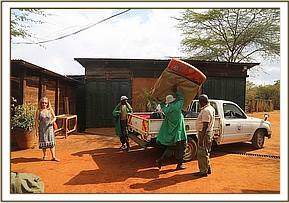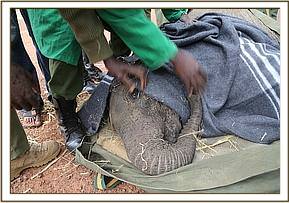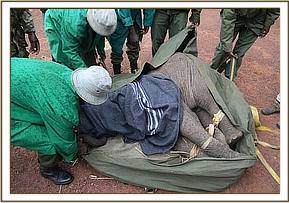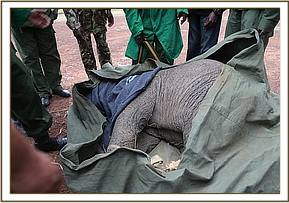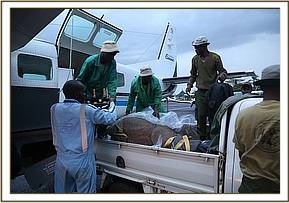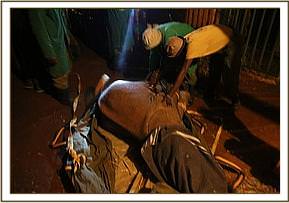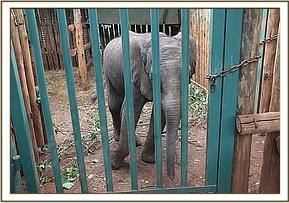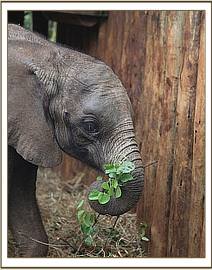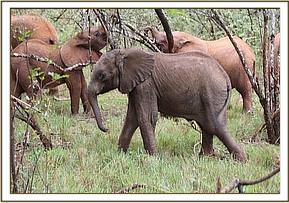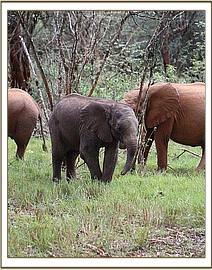






Has fully embraced his wild life in Tsavo East National Park
Current age
12 years old
Gender
Male
Rescued date
16 October 2014
Rescue location
Mount Kenya Region, Marania Farm
Date of birth (estimate)
9 October 2013
Reason orphaned
Poaching
Age at rescue
12 months old (approx)
Current location
Living Wild
The Mount Kenya wildlife corridor lies across Kisima and Marania Farms and has been a huge success, essentially re-linking the elephant populations of Samburu and Lakipia. Elephants that were once free to roam between habitats, but can no longer do so because of fencing and increased human development, can cause a huge amount of damage creating conflict with local communities therefore threatening their own survival. The electric fences of the Mount Kenya elephant corridor protect local communities from marauding elephants whilst enabling the elephants to migrate between two very diverse habitats in search of food, minerals and mates, and the Mount Kenya habitat provides a much needed dry season range for elephants . The corridor is approximately 14km long and opened in 2011. Initial worries that the elephants would be unwilling to use an underpass to cross the busy highway, linking Northern Kenya to the rest of the country, proved unfounded with the first elephant making the traverse within a month of opening. Hundreds of elephants were to follow in the subsequent months.
The baby elephant that was found on Marania Farm was thought to have slipped between the electric fences which prevent the large adult elephants from entering the fields. It seems likely that his mother was killed by poachers as three weeks earlier a carcass of a lactating female elephant was found with its tusks removed. The calf probably managed to stay with the herd for a while, possibly managing to scrounge some milk from another mother as his condition is fairly good, before becoming separated. The herd was nowhere to be seen when the baby was finally spotted by the Marania scouts. The scouts alerted Lewa Wildlife Conservancy who in turn notified the Kenya Wildlife Service and the Sheldrick Wildlife Trust.
Immediately after DWST was notified about the baby a rescue plane and team was arranged to fly to Lewa airstrip to meet up with Dr. Mutinda, a KWS vet, and his ground team.
Dr. Mutinda chose to anaesthetize the baby elephant and it was then transported by vehicle to Lewa airstrip where the KWS ground team met up with the SWT rescue team. Once the elephant calf was loaded onto the aircraft and safely secured he was revived to ensure that he did not remain under anaesthetic for too long as this is never advisable with baby elephants.
The Mount Kenya wildlife corridor lies across Kisima and Marania Farms and has been a huge success, essentially re-linking the elephant populations of Samburu and Lakipia. Elephants that were once free to roam between habitats, but can no longer do so because of fencing and increased human development, can cause a huge amount of damage creating conflict with local communities therefore threatening their own survival. The electric fences of the Mount Kenya elephant corridor protect local communities from marauding elephants whilst enabling the elephants to migrate between two very diverse habitats in search of food, minerals and mates, and the Mount Kenya habitat provides a much needed dry season range for elephants . The corridor is approximately 14km long and opened in 2011. Initial worries that the elephants would be unwilling to use an underpass to cross the busy highway, linking Northern Kenya to the rest of the country, proved unfounded with the first elephant making the traverse within a month of opening. Hundreds of elephants were to follow in the subsequent months.

View diary updates from across all our orphan units as written by the Keepers

Nearly six months have passed since Enkikwe was mauled by lions and very nearly killed, down on the Kalovoto River in Ithumba on the 1st of February 2018.
By adopting, you play a vital role in the life of an orphaned elephant, rhino, or giraffe — helping us provide the round-the-clock, loving attention each one needs and deserves over many years, so they can ultimately reclaim their place in the wild.
Your adoption supports the 100+ orphans in our care at any given time, covering the cost of milk and food supplies, Keepers' salaries, veterinary treatment, and other essentials.

Celebrate your adoption with a personalised certificate, ready for you or your lucky gift recipient to print and display!

Each month, we send a detailed update about our Orphans’ Project direct to your email inbox, featuring photos, stories, and special highlights.

From the latest Keepers’ Diaries to a downloadable image gallery and more, adopters have exclusive access to our content library.
